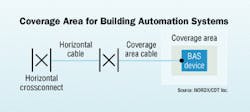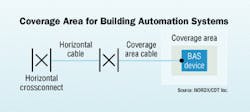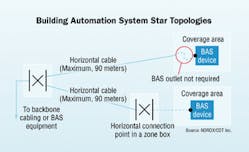A new standard designed to act as a guide for building automation systems cabling will, installers say, lead to better and more efficient installations.
"What the standard is doing is taking an outdated cabling system, one that has been obsolete for 10 years, and updating it," says Blair Robin, owner of Automated Home Technologies (www.autohometech.com), based in Brampton, Ontario.
The Telecommunications Industry Association (www.tiaonline.org) has published TIE/EIA-862 Building Automation Systems Cabling Standard for Commercial Buildings. It's designed to enable the design, planning and installation of a structured cabling system for building automation system (BAS) applications used in new or renovated commercial buildings and campuses.
The TIA's TR-42.1 Commercial Building Cabling Subcommittee document specifies a generic cabling system for building automation systems used in commercial buildings that will support a multi-product, multi-vendor environment. The standard also provides information that may be used for the design of BAS products for commercial enterprises. BAS equipment and devices are used in so-called "intelligent" buildings, which use structured cabling to power devices that open garage doors, and run security cameras, fire alarms, window shades, heating ventilation, lighting, electronic door openers, air conditioning and other controls. The systems depend on 22-gauge or 24-gauge twisted-pair cable.
Installers interviewed by Cabling Installation & Maintenance say they saw the trend toward intelligent buildings hitting a peak about two and a half years ago. While the recession slowed the trend, they now expect new construction this year and next. "We are starting to see good construction out there, and the smart building concept makes a lot of sense," says Herb Congdon, chairman of the TR-42.1 Commercial Building Cabling Subcommittee. "Because of that, we see an industry developing around the smart building."
"BAS is growing," agrees Julie Roy, IBDN technical support and certification manager for NORDX/CDT Inc. (www.nordx.com). "More and more BAS are starting to go in with the Ethernet protocol as a control."
Installation improvements
Installers say the standard's chief benefits are that it can:
- Lead to better installation by providing a common structure for cabling systems;
- Lead to the provision of interfaces to other sub-systems that are not always available in most buildings;
- Lead to greater ease when it comes to making moves, adds and changes (MACs).
In a world where installers are putting in proprietary wiring systems, the standard will aid in installation consistency. Until now, end users have been forced to take a particular vendor's door release or video camera, for example. If these items or their components became defective, the end user had no choice but to go to the original manufacturer for new parts.
"The cable you put in today is proprietary and will work with the system, but the problem comes if the system doesn't work any longer and the company has gone out of business," says Bob Jensen, a member of the TR-42.1 Commercial Building Cabling Subcommittee. "You can't always put in a new device from another manufacturer."
null
But now, many manufacturers will produce products according to the standard. And some installers believe the new standard will usher in a new line of cabling and components that are essential for easier installation of BAS systems. Jim Stewardson, a manager for Network and Automation Systems (www.nas.on.ca), a cable contractor based in Thunder Bay, Canada, says, for example, that the standard will bring much-needed uniformity to cables, components, and installation techniques.
"It's all wired to a structured location, so basically one installation company can do everything from electrical connections to connections for the controllers," says Stewardson. "This standardUgets things ready for the future."
Standard specifics
Specifically, the standard specifes the cabling needed to support them. It also covers devices specific to cabling by defining new components in the cabling infrastructure. The standard also defines common product performances, such as connector interfaces. It will likewise define common practices, showing installers how to achieve consistency among installations. "Before the standard, everyone had their own way of doing things," says Congdon. "Now, everyone can adopt commonalities."
Kirk McElwain, technical director for Continental Automated Buildings Association (www.caba.org), says many different types of installers are installing various cable solutions in buildings, but they are not working together. This has led to confusion, a lack of direction on the part of installers, and faulty systems. He says the standard could help remedy these problems.
"You have multiple trade groups working independent of each other, and there seldom is any integration of their systems with structured cabling implementation," says McElwain. "The way this industry has grown, you are bringing in people who install elevators, and they don't talk to the people who install security systems or telephone systems or any other system. Every trade group is separate, and no one person or organization is responsible for the overall integration of all the different systems."
The new standard has many similarities to the ANSI/TIA/EIA 568-B and 569-A standards for voice and data communications. The subcommittee tried to follow the 568 standard with the end goal of using the same media and terminology used in 568-B. This had the benefit of ushering in a common platform for BAS cabling. Many BAS systems are turning toward Ethernet, for example, and its topology is specified in the 568 document.
But the new standard differs in some important respects. Most notably, it defines coverage area served by a BAS device. The coverage area (CA) description for BAS is similar to the work area (WA) description for voice/data cabling. The coverage area refers to the space served by one BAS device. This could, for example, define the field of view of a security camera, or the area in which a thermostat can sense temperature changes. The size of this coverage area is typically about 25 square meters, based on average values from a study of floor lighting systems, security, and HVAC applications.
"For planning purposes, this standard will provide guidance on what the general coverage areas should be," says Congdon.
The standard also defines a modified star topology for horizontal and backbone cabling that can be easily configured to support known BAS application requirements. The topology shows the installer how to terminate cables in the same area, make connections to the telecom room, and maintain it. The topology essentially makes a chain from one cable device to another. The standard defines key elements of this horizontal cabling link, including the horizontal crossconnect (HC), horizontal cable, horizontal connection point (HCP), and an optional BAS outlet/connector.
Just as the name implies, the cable's outer sheet branches out in a star topology. The wires inside the cable can run from the telecom room and can be bridged at a horizontal connection point. The horizontal connection point covers a distance of 90 meters from the BAS device to the controller from the telecom room.
These wires can be daisy-chained out to bring life to the BAS applications. They can be connected to smoke detectors, sensors, or alarms for a home security system or other BAS devices, allowing all to be bridged together. This saves on the amount of wire to be distributed, and ultimately, the cost of the installation.
Without such a topology, a layout like this would be difficult to troubleshoot or in which to perform MACs. By following the star topology, the installer can remove a device without affecting others. And from this point, the design can accommodate different topologies, including those in different zones that cover different coverage areas.
McElwain says the standard will provide a blueprint for installers to follow as they complete the installation. "You won't have a whole spaghetti works of wire lying under the floor," says McElwain. "It's structured now. You know how it gets installed and where everything goes. It becomes a plug 'n' play deal instead of having to drag wires from point A to point B whenever there is a move, add or change."
Reasons for the standard
Congdon says the TIA committee interviewed installers, contractors and subcontractors as it formed the standard. "We created something that is generic enough so it will enable cabling people to plan, design, and install—whatever they need to be connected with a building automation system." Now that consultants and manufacturers alike can design according to the standard, in the long run, it will help the end user save money. "People like consistency among installations," says Congdon.
null
But despite these benefits, some argue that the standard falls short of making major changes in the installation of BAS devices. "The standard is there. That's good news," says McElwain. "But it won't change anything as far as the implementation. This isn't a cure by itself."
Others agree that the standard won't fix all of the challenges that come with BAS installations. But they also argue that it shouldn't be. "This isn't a cure-all for everything," says Jensen. "But I see it as an opportunity for people to change their cabling systems so they will be able to use something that is standardized, and use other standardized products out there."
Brian Milligan is senior associate editor for Cabling Installation & Maintenance.


